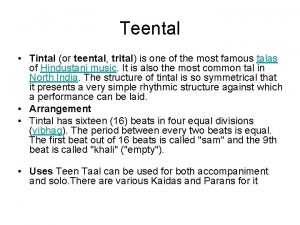Teental Tintal or teental trital is one of




- Slides: 4

Teental • Tintal (or teental, trital) is one of the most famous talas of Hindustani music. It is also the most common tal in North India. The structure of tintal is so symmetrical that it presents a very simple rhythmic structure against which a performance can be laid. • Arrangement • Tintal has sixteen (16) beats in four equal divisions (vibhag). The period between every two beats is equal. The first beat out of 16 beats is called "sam" and the 9 th beat is called "khali" ("empty"). • Uses Teen Taal can be used for both accompaniment and solo. There are various Kaidas and Parans for it

Teental • Theka • It has a characteristic pattern of bols (theka). • Theka for Tintal • Dha dhin dha | dha dhin dha | • X 2 dha tin ta | ta dhin dha | 0 3

Jhaptaal • • • jhaptal is one of the most famous talas of Hindustani music, after Teental. It presents quite a different rhythmical structure from teental, unlike which, it is not symmetrical. Arrangement Jhaptal is a 10 -beat pattern used in raga exposition. It has ten beats in four divisions (vibhag), of 2 -3 -2 -3, the third of which is the khali, or open division. To follow the tal the audience claps on the appropriate beat, which in jhaptal is beats 1, 3 and 8 (the first beat in each full division). A wave of the hand indicates beat 6, the first beat of the khali section. Theka for Jhaptal Dhi. Na|Dhi. Na|x 2 Ti. Na|Dhi. Na||o 3 Note the bols used for the first beat of each division: Dhi, is played at the beginning of the first, second and final divisions; for the khali section, Na - a right hand bol is used to indicate that the division is open.

Theka jhaptal Dhi na | dhi na X 2 Ti na | dhi na 0 3







